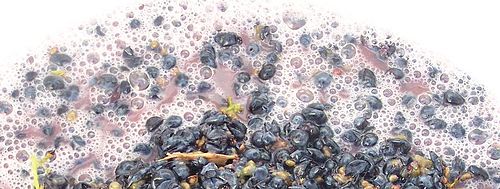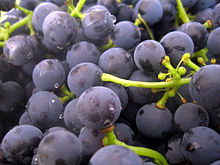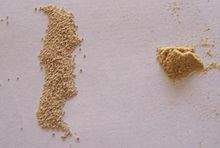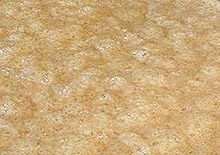- Fermentation (wine)
-
Fermenting must.

The process of fermentation in wine turns grape juice into an alcoholic beverage. During fermentation, yeast interact with sugars in the juice to create ethanol, commonly known as ethyl alcohol, and carbon dioxide (as a by-product). In winemaking, the temperature and speed of fermentation are important considerations as well as the levels of oxygen present in the must at the start of the fermentation. The risk of stuck fermentation and the development of several wine faults can also occur during this stage, which can last anywhere from 5 to 14 days for primary fermentation and potentially another 5 to 10 days for a secondary fermentation. Fermentation may be done in stainless steel tanks, which is common with many white wines like Riesling, in an open wooden vat, inside a wine barrel and inside the wine bottle itself as in the production of many sparkling wines.[1][2]
Contents
History
See also: History of wineThe natural occurrence of fermentation means it was probably first observed long ago by humans.[3] The earliest uses of the word "Fermentation" in relation to winemaking was in reference to the apparent "boiling" within the must that came from the anaerobic reaction of the yeast to the sugars in the grape juice and the release of carbon dioxide. The Latin fervere means, literally, to boil. In the mid-19th century, Louis Pasteur noted the connection between yeast and the process of the fermentation in which the yeast act as catalyst and mediator through a series of a reaction that convert sugar into alcohol. The discovery of the Embden–Meyerhof–Parnas pathway by Gustav Embden, Otto Fritz Meyerhof and Jakub Karol Parnas in the early 20th century contributed more to the understanding of the complex chemical processes involved in the conversion of sugar to alcohol.[4]
Process
In winemaking, there are distinctions made between ambient yeasts which are naturally present in wine cellars, vineyards and on the grapes themselves (sometimes known as a grape's "bloom" or "blush") and cultured yeast which are specifically isolated and inoculated for use in winemaking. The most common genera of wild yeasts found in winemaking include Candida, Klöckera/Hanseniaspora, Metschnikowiaceae, Pichia and Zygosaccharomyces. Wild yeasts can produce high-quality, unique-flavored wines; however, they are often unpredictable and may introduce less desirable traits to the wine, and can even contribute to spoilage. Traditional wine makers, particularly in Europe, advocate use of ambient yeast as a characteristic of the region's terroir; nevertheless, many winemakers prefer to control fermentation with predictable cultured yeast. The cultured yeasts most commonly used in winemaking belong to the Saccharomyces cerevisiae (also known as "sugar yeast") species. Within this species are several hundred different strains of yeast that can be used during fermentation to affect the heat or vigor of the process and enhance or suppress certain flavor characteristics of the varietal. The use of different strains of yeasts are a major contributor to the diversity of wine, even among the same grape variety.[5]
The addition of cultured yeast normally occurs with the yeast first in a dried or "inactive" state and is reactivated in warm water or diluted grape juice prior to being added to the must. To thrive and be active in fermentation, the yeast needs access to a continuous supply of carbon, nitrogen, sulfur, phosphorus as well as access to various vitamins and minerals. These components are naturally present in the grape must but their amount may be corrected by adding nutrient packets to the wine, in order to foster a more encouraging environment for the yeast. Oxygen is needed as well, but in wine making, the risk of oxidation and the lack of alcohol production from oxygenated yeast requires the exposure of oxygen to be kept at a minimum.[6]
Upon the introduction of active yeasts to the grape must, phosphates are attached to the sugar and the six-carbon sugar molecules begin to be split into three-carbon pieces and go through a series of rearrangement reactions. During this process, the carboxylic carbon atom is released in the form of carbon dioxide with the remaining components becoming acetaldehyde. The absence of oxygen in this anaerobic process allows the acetaldehyde to be eventually converted, by reduction, to ethanol. During the conversion of acetaldehyde, a small amount is converted, by oxidation, to acetic acid which, in excess, can contribute to the wine fault known as volatile acidity (vinegar taint). After the yeast has exhausted its life cycle, they fall to the bottom of the fermentation tank as sediment known as lees.[7]
Other compounds involved
 Brettanomyces, also known as "Brett", is a yeast strain commonly found in red Burgundy wine.
Brettanomyces, also known as "Brett", is a yeast strain commonly found in red Burgundy wine.
The metabolism of amino acids and breakdown of sugars by yeasts has the effect of creating other biochemical compounds that can contribute to the flavor and aroma of wine. These compounds can be considered "volatile" like aldehydes, ethyl acetate, ester, fatty acids, fusel oils, hydrogen sulfide, ketones and mercaptans) or "non-volatile" like glycerol, acetic acid and succinic acid. Yeast also has the effect during fermentation of releasing glycoside hydrolase which can hydrolyse the flavor precursors of aliphatics (a flavor component that reacts with oak), benzene derivatives, monoterpenes (responsible for floral aromas from grapes like Muscat and Traminer), norisoprenoids (responsible for some of the spice notes in Chardonnay), and phenols.
Some strains of yeasts can generate volatile thiols which contribute to the fruity aromas in many wines such as the gooseberry scent commonly associated with Sauvignon blanc.
Brettanomyces yeasts are responsible for the "barnyard aroma" characteristic in some red wines like Burgundy and Pinot noir.[8]Winemaking considerations
During fermentation, there are several factors that winemakers take into consideration. The most notable is that of the internal temperature of the must. The biochemical process of fermentation itself creates a lot of residual heat which can take the must out of the ideal temperature range for the wine. Typically, white wine is fermented between 64-68 °F (18-20 °C) though a wine maker may choose to use a higher temperature to bring out some of the complexity of the wine. Red wine is typically fermented at higher temperatures up to 85 °F (29 °C). Fermentation at higher temperatures may have adverse effect on the wine in stunning the yeast to inactivity and even "boiling off" some of the flavors of the wines. Some winemakers may ferment their red wines at cooler temperatures, more typical of white wines, in order to bring out more fruit flavors.[7]
To control the heat generated during fermentation, the winemaker must choose a suitable vessel size or else use a cooling device. Various kinds of cooling devices are available, ranging from the ancient Bordeaux practice of placing the fermentation vat atop blocks of ice to sophisticated fermentation tanks that have built-in cooling rings.[9]
A risk factor involved with fermentation is the development of chemical residue and spoilage which can be corrected with the addition of sulfur dioxide (SO2), although excess SO2 can lead to a wine fault. A winemaker who wishes to make a wine with high levels of residual sugar (like a dessert wine) may stop fermentation early either by dropping the temperature of the must to stun the yeast or by adding a high level of alcohol (like brandy) to the must to kill off the yeast and create a fortified wine.[7]
Other types of fermentation
In winemaking, there are different processes that fall under the title of "Fermentation" but might not follow the same procedure commonly associated with wine fermentation.
Bottle fermentation
Bottle fermentation is a method of sparkling wine production, originating in the Champagne region where after the cuvee has gone through a primary yeast fermentation the wine is then bottled and goes through a secondary fermentation where sugar and additional yeast known as liqueur de tirage is added to the wine. This secondary fermentation is what creates the carbon dioxide bubbles that sparkling wine is known for.[10]
Carbonic maceration
The process of carbonic maceration is also known as whole grape fermentation where instead of yeast being added, the grapes fermentation is encouraged to take place inside the individual grape berries. This method is common in the creation of Beaujolais wine and involves whole clusters of grapes being stored in a closed container with the oxygen in the container being replaced with carbon dioxide.[11] Unlike normal fermentation where yeast converts sugar into alcohol, carbonic maceration works by enzymes within the grape breaking down the cellular matter to form ethanol and other chemical properties. The resulting wines are typically soft and fruity.[12]
Malolactic fermentation
Instead of yeast, bacteria play a fundamental role in malolactic fermentation which is essentially the conversion of malic acid into lactic acid. This has the benefit of reducing some of the tartness and making the resulting wine taste softer. Depending on the style of wine that the winemaker is trying to produce, malolactic fermentation may take place at the very same time as the yeast fermentation.[13]
See also
References
- ^ J. Robinson (ed) "The Oxford Companion to Wine" Third Edition pg 267-269 Oxford University Press 2006 ISBN 0198609906
- ^ J. Robinson Jancis Robinson's Wine Course Third Edition pg 74-84 Abbeville Press 2003 ISBN 0789208830
- ^ H. Johnson Vintage: The Story of Wine pg 16 Simon and Schuster 1989 ISBN 0671687026
- ^ J. Robinson (ed) "The Oxford Companion to Wine" Third Edition pg 267 Oxford University Press 2006 ISBN 0198609906
- ^ J. Robinson (ed) "The Oxford Companion to Wine" Third Edition pg 778-779 Oxford University Press 2006 ISBN 0198609906
- ^ J. Robinson (ed) "The Oxford Companion to Wine" Third Edition pg 779 Oxford University Press 2006 ISBN 0198609906
- ^ a b c J. Robinson (ed) "The Oxford Companion to Wine" Third Edition pg 268 Oxford University Press 2006 ISBN 0198609906
- ^ J. Robinson (ed) "The Oxford Companion to Wine" Third Edition pg 780 Oxford University Press 2006 ISBN 0198609906
- ^ J. Robinson Jancis Robinson's Wine Course Third Edition pg 82 Abbeville Press 2003 ISBN 0789208830
- ^ K. MacNeil The Wine Bible pg 168-169 Workman Publishing 2001 ISBN 1563054345
- ^ K. MacNeil The Wine Bible pg 33-34 Workman Publishing 2001 ISBN 1563054345
- ^ D. Bird "Understanding Wine Technology" pg 89-92 DBQA Publishing 2005 ISBN 1891267914
- ^ K. MacNeil The Wine Bible pg 35 Workman Publishing 2001 ISBN 1563054345
Categories:
Wikimedia Foundation. 2010.




